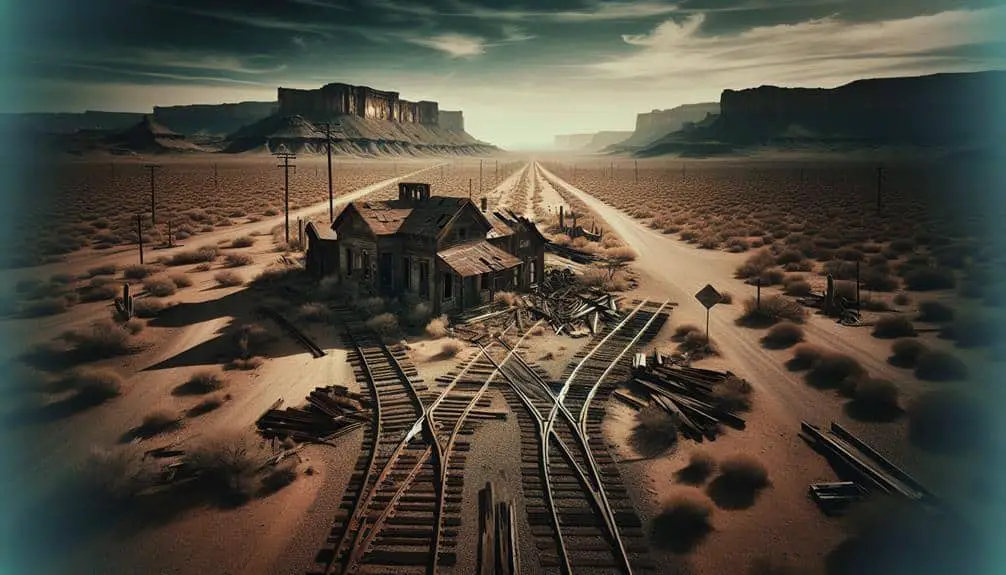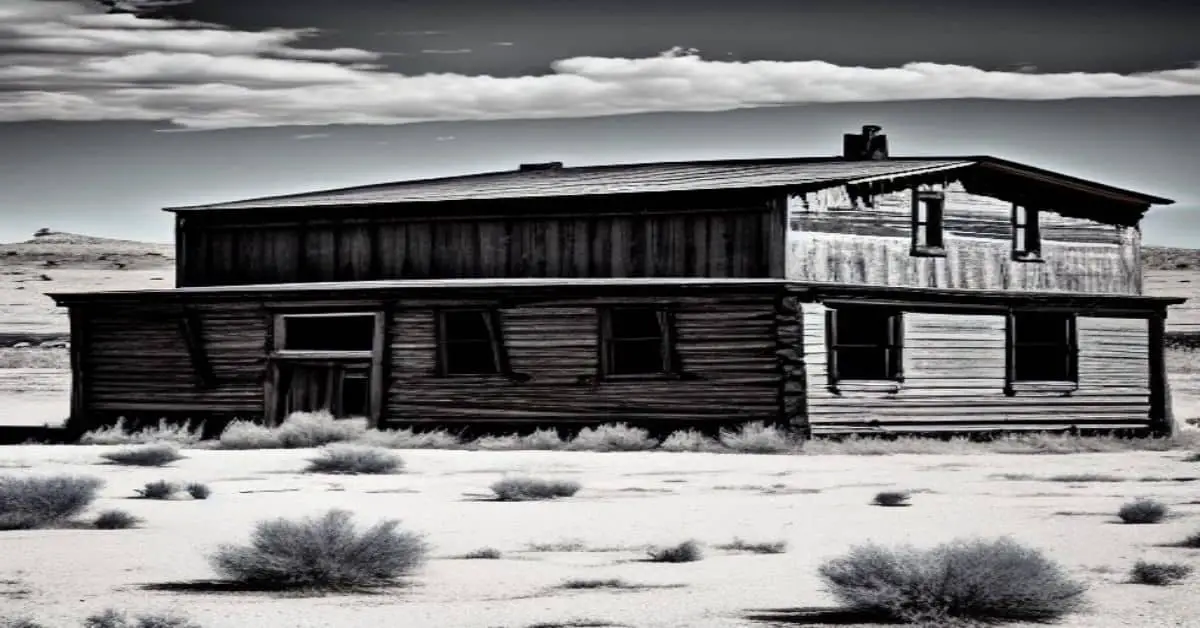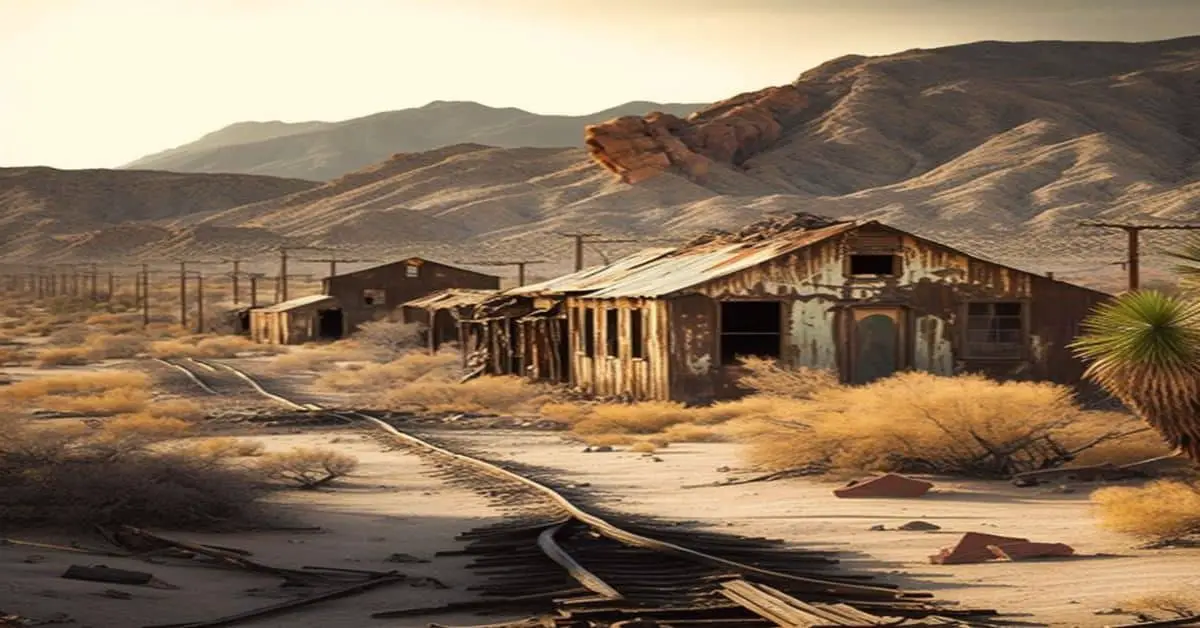Discover the fascinating past of Arizona's abandoned railroad junctions in ghost towns. Railroads were crucial, connecting mining communities and fostering economic growth. The emergence of technology and evolving transport needs led to their abandonment. Each deserted junction tells a distinctive story of development and eventual decline. Exploring these remnants reveals a bygone era and a rich cultural legacy, evident in the architecture and traditions. The conservation efforts underway aim to rejuvenate these once-thriving junctions, transforming them into living museums that showcase the history and vibrancy of Arizona's forgotten railroad communities.
Key Points
- Abandoned railroad junctions in Arizona reflect the state's rich history of railroad development and subsequent decline.
- These ghost towns were once vibrant communities that thrived around railroad junctions.
- Economic downturns, technological advancements, and changing transportation preferences contributed to the abandonment of these rail junctions.
- Preservation efforts aim to restore and safeguard these historical landmarks for future generations.
- Exploring these abandoned sites offers a glimpse into a bygone era and the cultural exchange between railroad workers and locals.
Origins of Arizonas Deserted Railroads
Exploring the origins of Arizona's deserted railroads reveals a complex history intertwined with economic shifts and changing transportation needs. The development of railroads in Arizona dates back to the late 19th century when the territory was experiencing a mining boom. As precious minerals were discovered in remote areas, the need for efficient transportation became paramount. Railroads were instrumental in connecting these mining towns to major cities, facilitating the movement of goods and people.
The origins of Arizona's abandoned railroads can be traced back to the ambitious expansion projects undertaken by various railroad companies seeking to capitalize on the state's natural resources. These railroads played a significant role in the development of Arizona's economy, opening up new opportunities for trade and commerce. However, as economic conditions shifted and industries evolved, many of these railroads became obsolete, leading to their eventual abandonment.
Understanding the origins of Arizona's abandoned railroads provides valuable insights into the state's economic history and the impact of transportation on its development. It's a reflection of the ever-changing nature of industry and the need for adaptation in the face of progress.
Impact of Railroads on Ghost Towns
The presence of railroads in Arizona's deserted areas left a lasting impact on the formation and evolution of ghost towns across the state, shaping their destinies in profound ways. The economic significance of railroads in the development of these ghost towns can't be overstated. The arrival of railroads brought newfound opportunities for trade and transportation, attracting settlers and businesses to these remote areas. As a result, towns sprang up around railroad junctions, thriving on the economic activity generated by the railway system.
Furthermore, the cultural heritage of these ghost towns is deeply intertwined with the history of the railroads. The diverse groups of people who worked on the railroads, from laborers to engineers, brought their traditions and ways of life to these towns, creating a rich tapestry of cultural exchange. The legacy of these interactions can still be seen in the architecture, cuisine, and customs of the ghost towns that once bustled with life. Today, these abandoned railroad junctions stand as poignant reminders of a bygone era, preserving a unique blend of economic and cultural history for future generations to explore.
Arizonas Forgotten Railroad Communities
Forgotten amidst the vast Arizona landscape are the remnants of once vibrant railroad communities, now silent echoes of a bygone era. These lost settlements, scattered throughout the state, stand as poignant reminders of the bustling life that once thrived alongside the forgotten tracks. From the dusty streets of Fairbank to the abandoned buildings of Gunsight, Arizona holds within its borders a treasure trove of forgotten railroad communities waiting to be rediscovered.
Each of these ghostly towns has a unique story to tell, a narrative of growth, decline, and eventual abandonment. In the shadows of the rugged mountains and under the scorching desert sun, these communities flourished before being swallowed by the sands of time. The echoes of past train whistles and the hustle and bustle of busy streets have long faded, leaving behind only whispers of the vibrant past that once was.
Exploring these forgotten railroad communities offers a glimpse into a different era, a chance to connect with history and experience the quiet beauty of these abandoned settlements. As you wander through the decaying buildings and along the overgrown tracks, you can't help but feel a sense of freedom, surrounded by the untamed wilderness and the ghosts of Arizona's railroad past.
Decline and Abandonment of Rail Junctions
Amidst the vast Arizona landscape lie the remnants of once vibrant railroad junctions, now silent witnesses to a bygone era of bustling activity. As you explore these abandoned sites, you can't help but wonder what led to their decline and ultimate abandonment.
- Economic Downturn: The decline of many railroad junctions in Arizona can be attributed to economic downturns that affected the region. Industries shifted, leading to a decreased need for rail transportation and causing these junctions to fall into disuse.
- Technological Advancements: With technological advancements in transportation, such as the rise of trucks and highways, railroads faced stiff competition. The efficiency and flexibility offered by other modes of transport made many rail junctions obsolete over time.
- Changing Demands: As the needs of industries and communities evolved, the once crucial rail junctions struggled to keep up. Changing demands and preferences for transportation further contributed to the abandonment of these historic sites.
These factors, among others, played a significant role in the decline and abandonment of rail junctions across Arizona, leaving behind a legacy of a bygone era.
Preservation Efforts for Ghost Town Railroads
Among the efforts to preserve the ghost town railroads in Arizona, enthusiasts and historians collaborate to safeguard these historical landmarks for future generations. Railroad restoration projects aim to bring back life to the once-thriving junctions, ensuring that the stories of the past aren't lost to time. Historical conservation plays an essential role in maintaining the authenticity of these sites, allowing visitors to step back in time and experience the heyday of the railroads.
Volunteers work tirelessly to restore old tracks, repair vintage locomotives, and reconstruct station buildings to their former glory. By piecing together photographs, blueprints, and oral histories, these preservationists recreate the atmosphere of a bygone era. The dedication and passion of these individuals shine through in the meticulous attention to detail present in every restored element.
Through these preservation efforts, ghost town railroads are transformed from forgotten relics into living museums that educate and inspire. By immersing yourself in the history of these railroads, you not only learn about the past but also contribute to ensuring that these remarkable pieces of history endure for generations to come.
Frequently Asked Questions
What Was the Primary Reason for the Decline and Abandonment of Railroad Junctions in Arizona?
When railroads faced an economic downturn in Arizona, the rise of technological advancements like automobiles and airplanes further contributed to the decline and abandonment of railroad junctions. These changes shifted the focus of transportation.
Are There Any Notable Ghost Towns in Arizona That Were Directly Impacted by the Presence of Railroads?
You may be surprised to learn that several ghost towns in Arizona owe their existence and decline to the impact of railroads. These historical sites hold significant importance and efforts are ongoing for preservation.
How Have the Abandoned Railroad Junctions in Arizona Affected the Local Economy and Communities?
When abandoned, railroad junctions in Arizona deeply impact local economies and community relations. The once crucial hubs now stand silent, affecting job opportunities and historical ties, leaving behind a haunting reminder of the past.
Are There Any Plans to Revitalize or Repurpose the Abandoned Rail Junctions in Arizona for Future Use?
If you're curious about revitalization efforts for abandoned railroad junctions in Arizona, there are indeed plans in motion. The future prospects include transforming these sites into vibrant hubs for tourism, recreation, and community development.
What Role Did the Construction of Highways and Roads Play in the Decline of Railroads and Ghost Towns in Arizona?
Did the rise of highways and roads overshadow the once bustling railroads in Arizona, leading to the demise of ghost towns? The impact of highways on transportation evolution greatly contributed to the decline.



